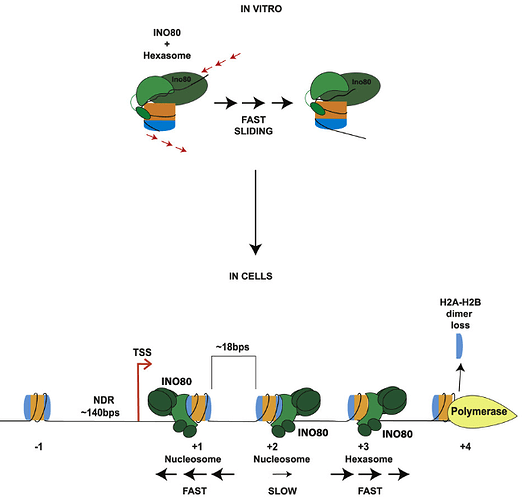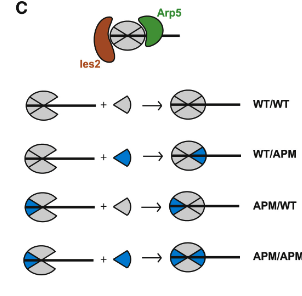The INO80 chromatin remodeling complex has long been the subject of intense study. Despite this, a recent report by Hsieh et al. in Molecular Cell reveals a new and unexpected biological activity: the INO80 complex (as compared to the other classes of chromatin remodelers) has a unique ability to act not only on nucleosomes but to enable transient detachment of an H2A-H2B histone dimer to form smaller hexasomes, which are slid and repositioned differently from nucleosomes.
Intriguingly, the authors demonstrate that the INO80 complex not only has the ability to act on hexasomes, but prefers to remodel hexasomes. Using in vitro biochemistry, they show that hexasomes are better substrates for the enzyme complex, better stimulate the enzyme’s ATPase activity, and are remodeled faster than full-size nucleosomes.
To explore the mechanisms underlying these observations, the authors asked about the acidic patches on H2A-H2B dimers. Given how previous studies had shown the importance of these patches for remodeling activity, the loss of one dimer of the two might be expected to hamper remodeling—not improve it. Instead, the team used a clever experiment with asymmetric nucleosomes containing mixtures of wild-type versus acidic patch mutant (APM) dimers to show how INO80 requires only a single acidic patch to maintain remodeling rates.
Arp5p is the protein within the INO80 complex that interacts most directly with acidic patches on histone H2 dimers. Using another series of in vitro experiments on reconstituted chromatin with a restriction enzyme accessibility assay and INO80(Δarp) (i.e. the complex lacking Arp5p), the authors show how the acidic patch specifically promotes formation of a key intermediate that primes the nucleosome for sliding along DNA.
That these complex experiments are so informative relies on the long history of studying yeast genes and proteins. These newer studies build on the breadth of earlier examinations to look at the complex abilities of protein assemblies to perform both overlapping and unique biochemical actions. The study of how chromatin is opened to allow transcription in a regulated fashion remains a critical area of study, for which yeast is an ideal model.


